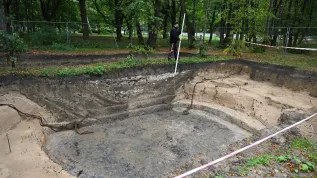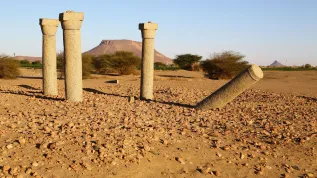
In Risan (Montenegro), a team of Polish researchers led by Prof. Piotr Dyczek of the University of Warsaw Antiquity of Southeastern Europe Research Centre discovered including another treasure of coins, more than 2 thousand years old walls and valuable pottery fragments.
"The results of this year\'s excavations in the capital of Queen Teuta exceeded our wildest expectations. After the last two campaigns, during which we discovered unique objects, it seemed that further excavations would bring scientific sensation. But Risan surprised us again" - said Prof. Piotr Dyczek.
Archaeologists studied the over 250 square meters area of the so-called house of Aglaos, a wealthy craftsman. They also made a major excavation on the axis of the ancient street dividing the two insula (houses) of the Hellenistic city from the time of Ballaios and Teuta (3rd century BC).
The most spectacular discovery is the treasure of coins. In the corner of one of the rooms the archaeologists found a pouchcontaining more than 100 coins with the image of the ancient ruler Ballaios.
"This is the second numismatic treasure of Risan we immediately started calling +a small treasure of Risan+. Although the number of coins does not seem impressive compared with the treasure discovered two years ago, we must be remembered that such large treasures of Hellenistic coins are extremely rare, and both treasures together are the total sensation unknown from other Hellenistic sites" - said the study leader.
For the first time during the excavations, the Polish team in Risan has managed to capture the walls of the city buildings from the late fourth and early third century BC. The history of settlement in Risan probably dates to 7th century BC. However, due to tectonic processes, its residues regularly fall deeper and the oldest archaeological layers are already below the groundwater level.
"This year the weather helped us. The great heat caused the rapid groundwater level decrease. This allowed us to capture the crown of very early walls built in the days when Risan was surrounded by a ring of mighty cyclops walls" - described by prof. Dyczek.
The previous layout was the same as the later city of Ballaios and Teuta, which proves that, despite the destruction, the original layout of the street grid had been preserved. This allows archaeologists to study urban planning from at least the fourth century BC.
"Uncovering earlier layers was automatically reflected in the repertoire of discovered objects. the The amount of ceramic tableware pieces significantly increased. There was a rich repertoire of other imported Hellenistic vessels: pottery from Campania, Attica, Corinth. Provenance of many vessels has not been determined even in the literature" - said the team leader.
For the first time in Risan, archaeologists have discovered a fragment of Attic red-figure krater. Another object that drew the attention of researchers was a piece of a bowl with relief decoration. The vessel wall depicts a horseback rider racing in the blown coat, carrying a lance ready to throw.
"This image is consistent with the descriptions of the iconography of the god Medaurus worshiped in Risan " - explains the professor. Dyczek.
Based on the discovery of numerous coins, archaeologists were able to make a more precise dating of individual layers and structures. They found many Greek coins from Greek cities and colonies on the Adriatic.
Archaeologists found that the early phase of settlement, at the turn of the fourth and third century BC, ended with destruction.
"We do not know its cause. Was it the result of an earthquake, common in the area, or an attack of enemies? We discovered burned buildings. However, shortly after these tragic events, the city was revived in a new, more beautiful form" - explained the archaeologist.
That was when the house of Aglaos was built (3rd/2nd century BC). The structure was discovered by Polish archaeologists in previous seasons, now its examination continued. New and better construction techniques were used to build the walls. The walls are solid and made of well cut and stacked stone. The individual rooms contained very good quality Gnathia vases and Hellenistic vessels covered with black varnish, as well as kitchen ceramics imported from the continental Greece.
"Sets of vessels, their quality and variety reminds of the finds from the Athenian agora. On many vessels writings are preserved containing Greek names of the vessel owners" - said Prof. Dyczek.
PAP - Science and Scholarship in Poland, Szymon Zdziebłowski
agt/ mrt/
tr. RL
Fundacja PAP zezwala na bezpłatny przedruk artykułów z Serwisu Nauka w Polsce pod warunkiem mailowego poinformowania nas raz w miesiącu o fakcie korzystania z serwisu oraz podania źródła artykułu. W portalach i serwisach internetowych prosimy o zamieszczenie podlinkowanego adresu: Źródło: naukawpolsce.pl, a w czasopismach adnotacji: Źródło: Serwis Nauka w Polsce - naukawpolsce.pl. Powyższe zezwolenie nie dotyczy: informacji z kategorii "Świat" oraz wszelkich fotografii i materiałów wideo.













